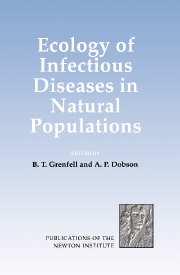Book contents
- Frontmatter
- Contents
- List of Participants
- Introduction
- BROAD PATTERNS AND PROCESSES
- PATHOGENS, INSECTS AND PLANTS
- Nonlinearities in the Dynamics of Indirectly-Transmitted Infections (or, does having a Vector make a Difference?)
- Model Frameworks for Plant-Pathogen Interactions
- The Dynamics of Insect-Pathogen Interactions
- IMPACT OF ECOLOGICAL AND GENETIC HETEROGENEITY
- Glossary
Model Frameworks for Plant-Pathogen Interactions
Published online by Cambridge University Press: 22 January 2010
- Frontmatter
- Contents
- List of Participants
- Introduction
- BROAD PATTERNS AND PROCESSES
- PATHOGENS, INSECTS AND PLANTS
- Nonlinearities in the Dynamics of Indirectly-Transmitted Infections (or, does having a Vector make a Difference?)
- Model Frameworks for Plant-Pathogen Interactions
- The Dynamics of Insect-Pathogen Interactions
- IMPACT OF ECOLOGICAL AND GENETIC HETEROGENEITY
- Glossary
Summary
Introduction
This paper is intended as a contribution to fulfilling the ‘need to link theory in plant disease epidemiology with similar theory in other areas of population biology’ (Jeger 1986). More particularly we focus on the similarities and differences between the theoretical frameworks that have emerged in plant pathology and animal or human infectious disease epidemiology. Although a number of workers (May 1990, Jeger 1984, Gilligan 1993, Gilligan 1990b, Heesterbeek and Zadoks 1987, Getz and Pickering 1983, Chan and Jeger 1994), have recognised this need and utilised results and methods more often seen in animal epidemiology, and such work is beginning to be incorporated into textbooks (Campbell and Madden 1990, Jeger 1989b), there is still a confusion in parts of the phytopathology literature over questions like the significance of threshold criteria in determining the persistence of an an infection in a defined host population, and the distinctions between epidemic, recurrent epidemic and endemic disease. In this paper we examine a number of these questions and expand on particular cases. We emphasise the construction of a theoretical framework which provides a basis for drawing together a number of different strands of plant epidemiology, and for melding ideas about transmission within a formula that captures the demography of the host and the impact of the pathogen. Some of these issues, like the putative existence of threshold host numbers for the establishment of infection, are common to many areas of epidemiology, but there are a number of distinctive problems faced by plant epidemiologists.
Two of the most distinctive features of plant pathosystems are the importance of spatial and genetic factors in determining disease spread.
- Type
- Chapter
- Information
- Ecology of Infectious Diseases in Natural Populations , pp. 280 - 294Publisher: Cambridge University PressPrint publication year: 1995
- 9
- Cited by



